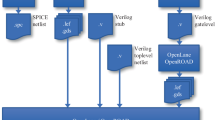Abstract
A methodology for analysis and synthesis of lowpass sigma-delta (ΣΔ) converters is presented in this paper. This method permits the synthesis of ΣΔ modulators employing continuous-time filters from discrete-time topologies. The analysis method is based on the discretization of a continuous-time model and using a discrete simulator, which is more efficient than an analog simulator. In our analysis approach, the influence of the sample and hold block and non-idealities of the feedback DAC can be systematically modeled by discrete-time systems. Finally, a realistic design of a second-order ΣΔ modulator with a compensation of the non-ideal behavior of the DAC is given. Moreover, simulation results show a good agreement with the theoretical predictions.
Similar content being viewed by others
References
J. C. Candy and G. C. Temes, Oversampling Delta-Sigma Data Converters. IEEE Press, New York,1991.
S. R. Norsworthy, R. Schreier, and G. C. Temes, Delta-Sigma Data Converters, Theory, Design, and Simulation. IEEE Press, PC3954,1997.
B. Agrawal and L. Shenoi, “Design methodology for sigmadelta modulators.” IEEE Transactions Communications 31, pp. 360–369,1983.
P. Benabes, “New bandpass sigma-delta modulators.” Ph.D. dissertation, Service des Mesures, SUPELEC, Paris, France, 1994 (in French).
P. Benabes, A. Gauthier, and R. Kielbasa, “A Multistage Closed-Loop Sigma-Delta Modulator (MSCL).” Analog Integrated Circuits and Signal Processing 11(3), pp. 195–204,1996.
C. V. Chakravarthy and M. N. Faruqui, “Two loop adaptive delta modulation systems.” IEEE Transactions Communications22, pp. 1710–1713,1974.
J. C. Candy, W. H. Ninke, and B. A. Wooley, “A per channel A/D converter having 15-segment m255 companing.” IEEE Transactions Communications. 24, pp. 33–42,1976.
R. J. Van De Plassche and R. E. J. Van Der Grift, “A Æve digit analog digital converter.” IEEE Journal of Solid-State Circuits 12, pp. 656–662,1977.
R. J. Van De Plassche, “A sigma-delta modulator as an A/D converter.” IEEE Transactions Circuits & Systems 25, pp. 510–514,1978.
C. V. Chakravarthy, “A class of companded unity bit coders.” IEEE Transactions Communications 30, pp. 1773–1775,1982.
R. Koch, B. Heise, F. Eckbauer, E. Engelhardt, J. A. Fisher, and F. Parzefall, “A 12 bit SD analog-to-digital converter with a 15MHz clock rate.” IEEE Journal of Solid-State Circuits 21, pp. 1003–1010,1986.
J. F. Jensen, A. E. Cosand, and R. H. Walden, “A 3.2-GHz second-order delta-sigma modulator implemented in InP HBT Technology.” IEEE Journal of Solid State Circuits 30, pp. 103–106,1995.
A. Gosslau and A. Gottwald, “Optimization of a SD modulator by the use of a slow ADC.” in Proceedings IEEE International Symposium. Circuits & Systems, pp. 2317–2320,1988.
R. Schreier and B. Zhang, “Delta-Sigma modulators employing continuous-time circuitry.” IEEE Transactions Circuit & Systems-I: Fundamental Theory and Applications 43, pp. 324–332,1996.
O. Shoaei, Continuous-time delta-sigma A/D converters for high speed applications, Ph.D. dissertation, Carleton University, Canada,1995.
M. B. Monagan, K. O. Geddes, K. M. Heal, G. Labahn, and S. Vorloetter, Maple V Programming Guide. Springer-Verlag, 1996.
Users Guide Mathematica: A System for Doing Mathematics by Computer. Wolfram Research.
G. F. Franklin and J. P. Powell, Digital Control of Dynamic Systems. Addison-Wesley Publishing Company,1980.
J. C. Candy, “A use of double integration in sigma delta modulation.” IEEE Transactions Communications 33, pp. 249–258,1985.
P. Benabes, M. Keramat, and R. Kielbasa, Synthesis and analysis of sigma-delta modulators employing continuous-time Ælters. Ecole Superieure d'Electricite (SUPELEC), Paris, France, Tech. Rep. No. SUP-0996–21,1996.
P. Benabes, P. Aldebert, and R. Kielbasa, “A Matlab based tool for bandpass continuous-time sigma-delta modulators design.” in Proceedings IEEE International Symposium Circuits & Systems Monterey, CA, 6, pp. 274–277,1998.
Author information
Authors and Affiliations
Rights and permissions
About this article
Cite this article
Be´nabe`s, P., Keramat, M. & Kielbasa, R. Synthesis and Analysis of Sigma-Delta Modulators Employing Continuous-Time Filters. Analog Integrated Circuits and Signal Processing 23, 141–152 (2000). https://doi.org/10.1023/A:1008346026468
Issue Date:
DOI: https://doi.org/10.1023/A:1008346026468




